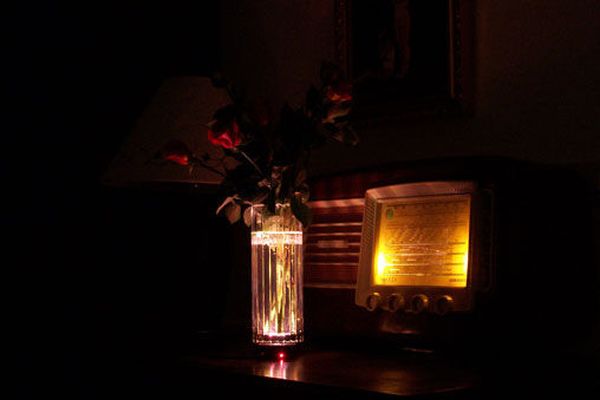A remote controlled power RGB LED mood light.
With this thing I can control the colour of a bright light into many different colours using the three fundamentals colours : red green and blue. Adding them toghether with different intensity can yeld very great a range of colours from the visible spectrum.
Specifically my mood lamp can shift colours through 32 intensity values for each RGB colour giving
32*32*32 = 32768 different combinations of hue, intensity and brightness. It can also store 10 different combinations can be turned on or off, all of these through a TV remote control.
The intensity of each red, green and blue component is done via PWM so heat dissipation is kept to a minimum.
The circuit is simple and there are no pushbuttons as control is done entirely through the remote control.
I use this circuit to light a flower vase. The flat case of the box I chose does a good job at balancing the vase.
The pictures provide some ideas.
One day I am possibly buying one of those glass cubes with LASER created 3D shapes inside to go with the lamp. For now glass vases are just fine.
UPDATE : I uploaded V1.1 where at power up the micro outputs the values from memory number 0. Just make sure you store your power up colour in memory number 0 and at power up it will show up. If you’d rather go for lights off, just store all blanks in memory numer 0.
Ciao

Hey I’m on the best of Instructables book !
Description
It could be replaced by cheaper and probably equivalent ones; when I designed this, it was the only one suitable I could find.
Due to the LED’s high power rating it is absolutely necessary to provide it with a reasonable heat sink like the one you see in the photos; before putting the finished circuit in a case check the LEDs for heat at maximum intensity on all of the three colours. The current limiting resistors I chose match my LED only !
I chose a 10% less than the typical recommended V-I values on the datasheet curves.
Being the circuit in a plastic case it is not safe to pull dissipation any higher while a metallic case with an external dissipation scheme might make safe to pull the LEDs currents a make a more powerful beam.
Different LEDs do have different ratings. Check the datasheets for maximum dissipation and recommendations for your LED.
I purchased my LED online from Distrelec. Farnellinone carries them also.
The drivers are surplus NPN transistors over-dimensioned for the current required. Less powerful TO126 encased NPNs should do fine. As the Transistor are driven with PWM, their dissipation is kept to a minimum so heat sink is not necessary.
The IR receiver is one i savaged from a dead TV toghether with the remote control. The receiver has a metallic screen that should be grounded to 0V. Some newer small-sized ones are from Temic and can be bought from the same sources as above. Practically any receiver works fine, provided that it has 5Volt logic levels (and supply) and has the same (or close) carier frequency as the remote transmitter (typically 38-50kHz). When demolishing a TV or any other remote controlled piece of equipmentm, a good rule is to save both the remote and the receiver. By the way, I love saving transformers, VFD, motors as well, but that’s another story.
This lamp uses an european RC5 standard for Philips TV remotes; Any programmable remote control that supports Philips TVs should be fine, I tried one and it works.
Both remote decoding and PWM generating routines should be understandable from the source code I commented.
